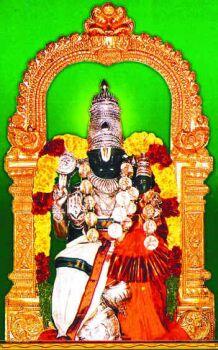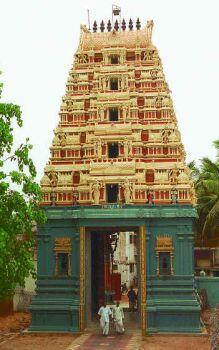Brahmotsavam is taking place at SriLakshmiNrisimha Thirukoil, Nanganallur from March 4, 2012 through March 14, 2012. Perumal gave sevarthis darshanam in Kudhirai Vahanam on March 11th evening. The following is the related video..
Courtesy: Sri Rengarajan Swami
Also visit: http://anudinam.org/2012/03/07/nanganallur-sri-lakshminrisimha-thirukoil-garuda-sevai/
About the temple
An Ancient temple, which had totally disappeared due to the ravages of time but was restored to its glory is the Lakshmi Nrisimha, Navaneethakrishnan Temple in modern Nanganallur, a suburb of Chennai, whose original name according to scholars was Nangainallur or the place where Goddess Mahalakshmi is enshrined and worshipped. The Narasimha temple has been built over the remnants of what was an ancient temple, which existed during the pre-Pallava period.
The Narasimha temple, which has been built on a 10-ground site, was over 1,500 years old, according to the “Ashtamangala Prasnam” conducted by Sri Narayana Namboodiri of Guruvayur. The Prasnam revealed that the original temple had shrines for Lords Lakshmi Narasimha, Navaneethakrishnan, Rama and Srinivasa and new shrines for these deities should be built. It also said the entire temple complex was razed to the ground in a fire centuries ago and “Bhoomi Sankarshana” should be performed there. It was also predicted that the digging would bring up some archa-vigrahas and puja articles along with the ruins of the ancient temple.
The levelling of the temple site started on April 5, 1974, and a bell, a plate and a lamp were recovered. The bell is said to be of rare kind as its top portion contains the images of both Sudharsana ( and the Panchajanya one inlaid in the other. A stone with an inscription was also found and it said that a land gift was made by “Kaveri Thenkarai Ravichathiran” to keep the two “Nandavilakkus” going. These articles as well as the five-and-a-half feet high archa-vigraha of Mahavishnu found made the archaeologists conclude that the temple was built in the eighth century during the Pallava rule.
The members of the Krishna Bhakta Jana Sabha took the photos of the recovered articles and archa-vigrahas to Kanchipuram and met the Paramacharya on May 2, 1974, and explained the same to him. The sage of Kanchi blessed them. Sudarsana Homam, Sri Suktha Homam and Bhoomi Sankarshana Puja were conducted at the site on May 24 and Thirukkallam Sri Narasimha Raghavachariar, a renowned scholar, conducted the “Sthala Puja.” Efforts of the Sabha bore fruit when the Lakshmi Narasimhar Temple was constructed and the Ashtabandana Mahasamprokshanam was performed on December 14, 1975. The “Sudarsana Yantram,” which was kept in the Chakarathazhwar shrine at Kancheepuram, was brought to Nanganallur and installed under the Peetam of the archa-vigraha by Sri Jayendra Saraswathi. Yagasala puja and other rituals preceded the Samprokshanam and the temple was then consecrated. The Sabha also introduced the “Pidi Arisi Thittam” by collecting one handful of rice and one rupee from the public for conducting the daily puja and other rituals.
The temple complex slowly took shape with the construction of the Veera Anjaneya shrine through public donations and the Samprokshanam was performed in December 1976. “Koti Archanai” was conducted for Sri Lakshmi Narasimhar from June 19, 1978 and special “Thirumanjanam” with 473 Kalasams was performed to the Lord and His Consort. In course of time, the shrines of Sri Rukmani-Sathyabhama Sametha Sri Navaneethakrishnan, Sri Kothandarama, Sri Srinivasa, Sri Andal, Azhwars and Acharyas, including Sri Ramanuja and Sri Vedanta Desika, were established.
Sri Mukkur Lakshminarasimhachariar was a great source of inspiration for the Sabha members and the Lord was said to have appeared in his dream and told him that the temple existed in the Thretha Yuga and was known then as “Dakshina Deepalaya.” It was here that Sage Jamadhagni, father of Parasurama, an incarnation of Lord Narayana, conducted the Narasimha Mahayagnam when the Lord appeared before him and he requested Him to stay in the place and bless the devotees.
The temple is a complete complex now with the Sudarsana shrine in the form of a car with “Vedachakra Vimanam.” The archa-vigraha of Sudarsana carries all the 16 weapons and on the other side is the image of Narasimha, seated on “Panchamuka Adisesha”. Another speciality in the temple is that the Lord’s Holy Disc, which was in “Prayoga Chakra” form and was unearthed during the digging operations, has been installed in front of the Chakarathazhwar shrine.
The temple has a 55 feet high and 30 feet wide Rajagopuram with five tiers and seven Kalasams. As one enters the temple through the Rajagopuram, he can worship Lord Ranganatha and Lord Krishna and then the 44th and 45th Jeeyars of Ahobila Math and Sri Mukkur Lakshmi Narasimhachariar in the Muka Mandapam. The doors of the Rajagopuram contain intricately carved floral designs and images of the Lord’s incarnations.
Many annual and monthly festivals are conducted in the temple of which the most important is the Narasimha Jayanthi celebrated for five days in May.










